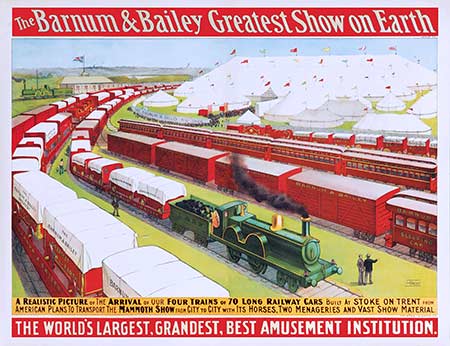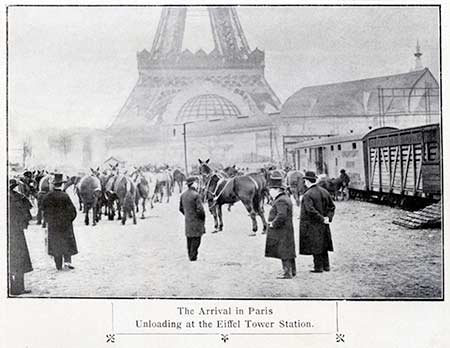| |
|

When James A. Bailey (partner P.T. Barnum had died in 1891) decided to take his circus to the Old World for five years (leaving a vacuum that the Ringling circus quickly exploited), he needed a new train for the compact European rail system.
Sixty-seven new-build rail cars were ordered from WR Renshaw of Stoke-on-Trent (Phoenix Works), Staffordshire, England. Sixty-six would comprise four trains (sections), each to be powered by a pair of goods locomotives supplied by the hosting railway. One advertising car would run in advance of the circus by a few weeks, tied to the back of scheduled passenger trains. The circus poster boasted 70 long cars, but all such advertising had a history of estimation and hyperbole.
Still, the cars were the longest yet constructed to ply the British rail system. Each car was 57 feet in length - so long that the Advertising Car was the sole car allowed to be transported on ordinary trains. Designs for flat cars and stock cars had to be specially modified for European rail clearances while still providing space for very large loads. Despite the specially designed flat cars, several of the circus wagons had to be shortened before they left the States. Oddly, most of the new rail cars had American-style knuckle couplers, though the Advertising Car did not. Special connecting devices or whole buffer/barrier cars with one British and one American-style coupler made the connections to the locomotives. The passenger cars and stock cars borrowed heavily from contemporary American designs, aided by a contract engineer from Barney & Smith in Dayton, Ohio, further distinguishing this show as a uniquely American spectacle.
The circus had played a 16-week engagement at Olympia in London all the way back in winter 1889-90. Having tested the waters, Bailey had longed to return. On November 12, 1897 the Barnum & Bailey Circus, minus tents and wagons, left the US for England to play Olympia for the winter. Come spring the tents and wagons had arrived from America and it was time to hit the road - but the new train cars weren't ready. Local rail cars were pressed into service, and on April 11, 1898 the show opened on-the-road in Manchester. Birmingham was next at the end of May and this is where the first of the new sleeping cars arrived. It wasn't until July 16, 1898 that the last of the sleepers and Bailey's private car were delivered - just in time for the journey north to Edinburgh, Scotland. The new circus train was finally complete.
The circus and its train toured England for two seasons (playing Olympia again the winter of 1899/1900) before moving to the continent by ship. On March 22, 1900 the train was offloaded from the SS Michigan at Hamburg, Germany. After a 4 week run there, the train toured 55 towns in Germany (where a mishap in Beuthen July 6, 1901 resulted in Renshaw building some replacement cars at the German government's expense), before ending 1900 in Vienna, Austria for a long winter engagement.
The year 1901 saw the train leave Vienna and head to Hungary, Croatia, Austria, modern-day Czech Republic, modern-day Poland, Germany, Holland, and Belgium.

The year 1902 saw the train criss-crossing France and Switzerland. The circus, minus its new train, returned to New York in the summer of 1902. James A. Bailey died in 1906 and his Greatest Show on Earth merged with Ringling in 1907.
Fifty of the Barnum European rail cars next went to Buffalo Bill Cody's Wild West Show which had come under Barnum management, touring England and Europe in 1903-1906. Afterwards, some cars went to Chatterley Whitfield Colliery to transport miners. Some were immediately scrapped. Just one Barnum & Bailey Renshaw-built circus train car remains today, having survived over 120 years and two world wars - a sleeper car at the National Museum in Cardiff.
This
list is a work-in-progress -- and probably always will be.
Any additions or corrections, please email. |



